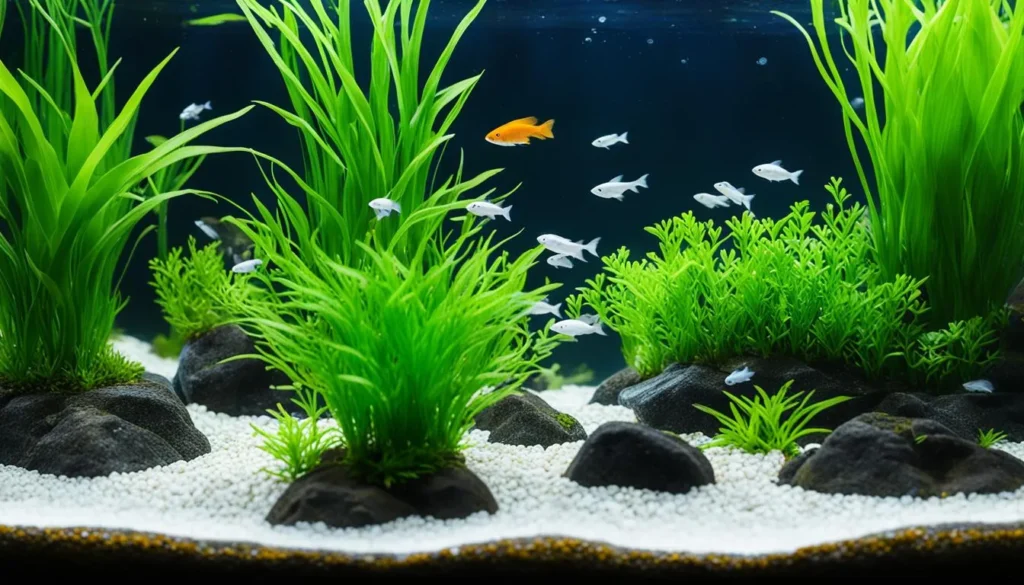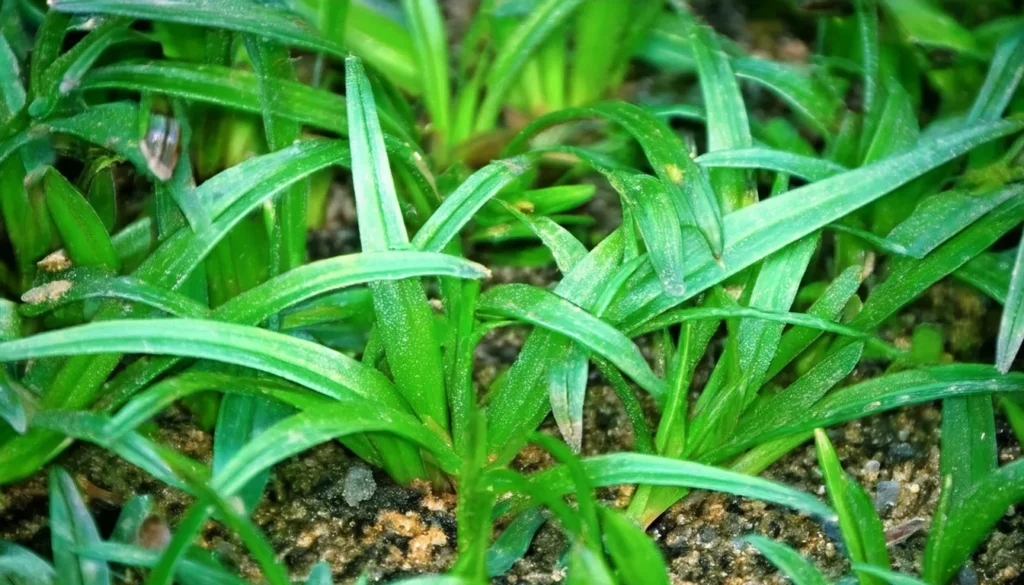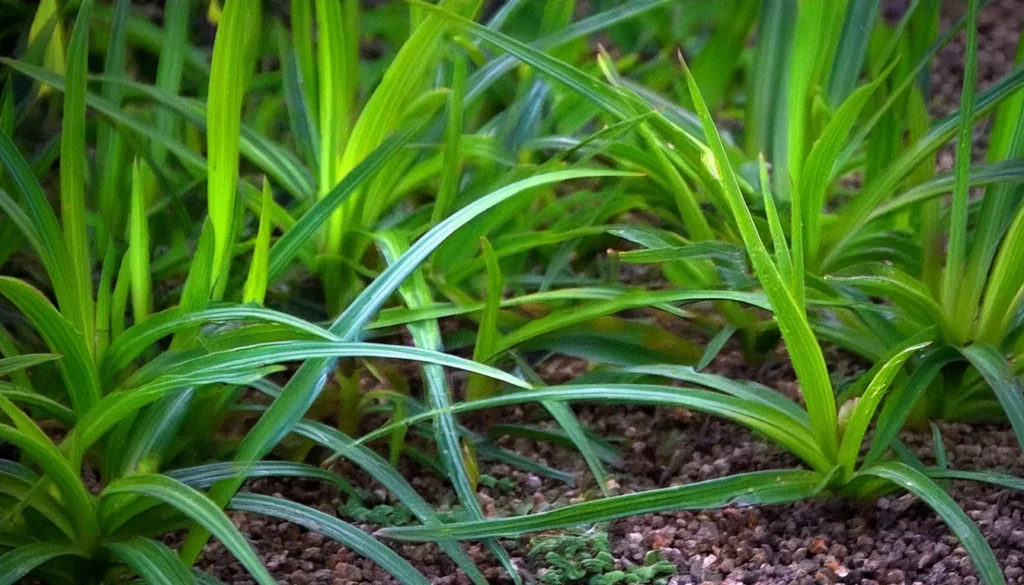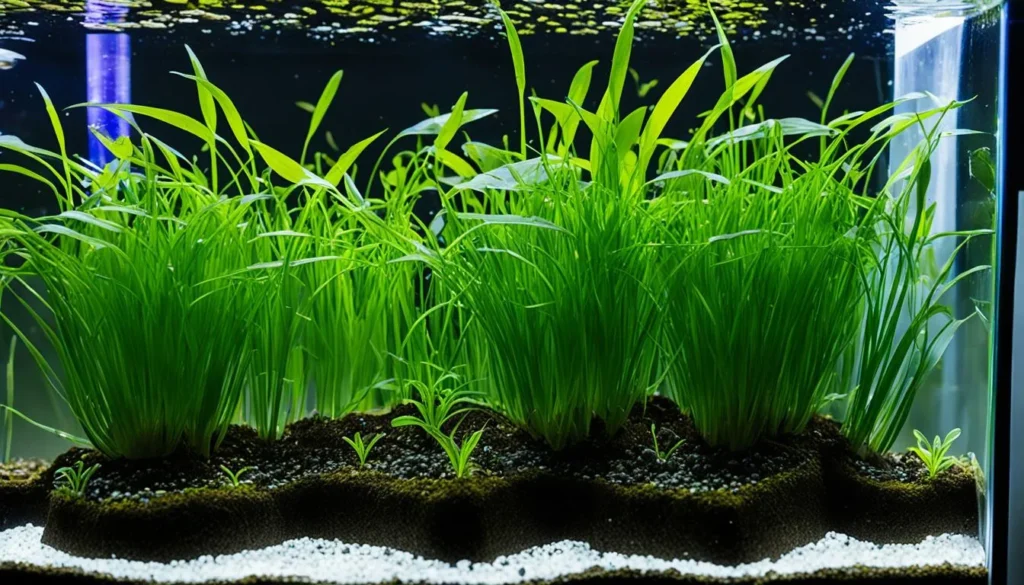Welcome to our comprehensive care guide for Dwarf Sagittaria, a popular aquatic plant for beginners in freshwater aquariums.
As passionate aquarists, we understand the joy of creating a vibrant underwater landscape and the importance of providing optimal care for our aquatic plants.
In this guide, we will walk you through everything you need to know about caring for Dwarf Sagittaria, from its characteristics and native habitats to setting up your aquarium, lighting, substrate, water parameters, planting techniques, CO2 and fertilization, common issues, propagation, essential maintenance practices, its aesthetic appeal in aquascaping, compatibility with other aquarium inhabitants, and more.
Whether you’re new to aquatic gardening or looking to expand your plant collection, this guide will equip you with the knowledge and skills to successfully care for Dwarf Sagittaria in your freshwater aquarium.

Key Takeaway
- Dwarf Sagittaria is a popular aquatic plant ideal for beginners in freshwater aquariums.
- Understanding its characteristics and native habitats is crucial for providing optimal care.
- Proper aquarium setup, including lighting, substrate, and water parameters, is essential for the plant’s growth and well-being.
- Mastering planting techniques, CO2 supplementation, fertilization, and maintenance practices will promote the health and aesthetic appeal of Dwarf Sagittaria.
- Ensure compatibility with other aquarium inhabitants by considering symbiotic relationships and maintaining a balanced ecosystem.
Quick Stats
| Attribute | Details |
| Family Name | Alismataceae |
| Origin | North and South America |
| Height | 5-15 cm (2-6 inches), can grow taller under low light |
| pH Range | 6.0 – 7.5 |
| CO2 Requirement | Low |
| Growth Rate | Moderate |
| Care Level | Easy |
| Color Form | Bright Green |
| Water Conditions | 18-28°C (64-82°F), adaptable to a wide range of hardness |
| Max Size | Leaves can grow up to 15 cm (6 inches) tall |
| Lighting | Low to Moderate |
| Supplements | Benefits from root tabs; liquid fertilizers can support more lush growth |
| Placement | Foreground to Mid-ground |
| Propagation | By runners |
What Is Dwarf Sagittaria?
Welcome to the fascinating world of Dwarf Sagittaria, a popular aquatic plant among aquarists.
Also known as Sagittaria subulata, this plant is highly sought after for its attractive appearance and ease of care.
With its grass-like foliage and delicate white flowers, Dwarf Sagittaria adds a touch of elegance to any freshwater aquarium.
Dwarf Sagittaria’s Native Habitats
Dwarf Sagittaria is native to North and Central America, where it grows in both submerged and emersed habitats.
It is commonly found in marshes, lakes, and slow-moving rivers in the wild. The plant’s ability to thrive in different environments is a testament to its resilience and versatility.

Physical Characteristic
- Dwarf Sagittaria’s popularity can be attributed to several factors. Its slender leaves, which resemble blades of grass, create a natural and serene underwater landscape. This aquatic plant’s ability to thrive in a variety of water conditions makes it an excellent choice for both beginners and experienced hobbyists.
- In terms of size, Dwarf Sagittaria usually reaches a height of 10-15 cm (4-6 inches). Its growth pattern involves sending out runners that spread horizontally, forming dense, lush carpets. Additionally, the plant produces small white flowers that can add a touch of beauty to your aquarium.
- One of the standout features of Dwarf Sagittaria is its adaptability. It can tolerate a wide range of water parameters, including temperature, pH, and water hardness, making it ideal for a diverse range of aquarium setups.
The Significance Of Proper Lighting
- Proper lighting is essential for the photosynthesis process in plants, including Dwarf Sagittaria. Adequate light intensity and spectrum are critical for the plant’s growth and overall well-being.
- Consider using aquarium lighting systems specifically designed for planted tanks. LED lights are an excellent choice as they provide energy-efficient illumination and can be adjusted to simulate natural daylight.
- It is recommended to provide a light duration of 8 to 10 hours per day to allow for sufficient photosynthesis.
RELATED: Dwarf Chain Sword For A Lush Carpet In Your Aquascape
Temperature Parameters For Robust Growth
- Tropical Range: Dwarf Sagittaria thrives in temperatures typically found in tropical freshwater environments, ranging from 72-82°F (22-28°C). This temperature range mimics its native habitats, providing the warmth necessary for healthy growth and development.
- Consistency is Key: Aim for stability in temperature levels within the aquarium. Sudden fluctuations, especially drastic drops or rises, can stress the plant and hinder its growth. Use a reliable aquarium heater to maintain consistent temperatures and ensure the well-being of your Dwarf Sagittaria.
- Monitoring and Adjustments: Regularly monitor the water temperature using a reliable aquarium thermometer. Make adjustments to the heater settings as needed to maintain the desired temperature range. Additionally, consider factors such as room temperature and seasonal changes, as they can influence the aquarium temperature and may require adjustments to maintain optimal conditions for your Dwarf Sagittaria.
Regulating Water Parameters For Dwarf Sagittaria Growth
- Regulating water parameters is vital for the successful growth of Dwarf Sagittaria. Factors such as pH, temperature, and hardness can significantly impact the plant’s overall health and development.
- Optimal water parameters for Dwarf Sagittaria typically range from a pH of 6.5 to 7.5, a temperature between 72°F and 82°F (22°C to 28°C), and a moderate hardness level.
- Monitoring and adjusting these parameters regularly is important to ensure they remain within the ideal range for your plants.

Choosing The Right Substrate
- When selecting a substrate for your Dwarf Sagittaria, choosing one that supports root feeding is important. A nutrient-rich substrate can provide essential nutrients directly to the plant’s roots, promoting healthy growth and development.
- Consider using substrates specifically designed for aquatic plants, as they usually contain beneficial nutrients and minerals.
- Examples of suitable substrates include nutrient-rich soil, clay-based substrates, or specialized aquatic plant substrates.
Placement Option In The Tank
- Foreground or Midground Planting: Dwarf Sagittaria is typically used as a foreground or midground plant in aquariums due to its relatively short stature. Plant it in groups or clusters at the front or middle areas of the tank to create a lush carpeting effect or to add visual interest and texture to the lower portions of the aquascape.
- Spacing Considerations: When planting Dwarf Sagittaria, allow sufficient spacing between individual plants to accommodate their spreading growth habit. This spacing ensures that each plant receives adequate light and access to nutrients, preventing overcrowding and promoting healthy development.
- Aquascape Design: Incorporate Dwarf Sagittaria into your aquascape design to create depth and perspective. Use it to define pathways or borders within the tank, or to complement taller background plants and hardscape elements. Experiment with different planting arrangements and layouts to achieve your desired aesthetic and functional goals for the aquarium.
Recommended Tank Size
- Nano Tanks: For nano tanks with a capacity of 5 gallons (19 liters) or larger, Dwarf Sagittaria can be used as a foreground or midground plant. Its compact size makes it suitable for smaller aquariums, but ensure adequate spacing to prevent overcrowding.
- Standard Tanks: For standard-sized tanks ranging from 10 gallons (38 liters) to 55 gallons (208 liters) or more, Dwarf Sagittaria can be used in larger quantities to create lush carpeting or to fill out foreground areas. Consider the dimensions and footprint of the tank when planning the layout to ensure proper coverage and aesthetics.
- Bigger Tanks: In larger tanks exceeding 55 gallons (208 liters), Dwarf Sagittaria can be used as a foreground or midground plant, or even as a transitional element between different sections of the aquascape. Its versatility allows for creative placement and arrangement in various tank sizes.

Suitable Tank Mates For Dwarf Sagittaria
- Peaceful Community Fish: Small, peaceful fish that inhabit different levels of the aquarium, such as tetras, rasboras, danios, and guppies, can coexist harmoniously with Dwarf Sagittaria.
- Shrimp and Snails: Invertebrates like cherry shrimp, amano shrimp, and various snail species, such as Nerite snails, can help clean up detritus and algae while complementing the peaceful nature of Dwarf Sagittaria.
- Bottom Dwellers: Fish species that inhabit the bottom of the tank, such as Corydoras catfish and Otocinclus catfish, can safely inhabit the same space as Dwarf Sagittaria without causing any conflicts.
- Dwarf Cichlids: Some dwarf cichlid species, such as Apistogramma and German Blue Rams, can be compatible tank mates for Dwarf Sagittaria, provided the tank is spacious enough and there are plenty of hiding spots and territories.
- Other Aquatic Plants: Many other aquatic plant species can coexist with Dwarf Sagittaria, enhancing the overall aesthetics of the aquarium and providing additional benefits such as nutrient uptake and oxygenation.
Nutritional Needs Of The Plant
Dwarf Sagittaria requires a balanced supply of macro and micro nutrients to thrive:
Macro Nutrients
- Nitrogen (N): Essential for protein synthesis and overall growth. It can be provided through nitrates (NO3-) and ammonium (NH4+).
- Phosphorus (P): Vital for energy transfer, cell division, and root development. Phosphate (PO4^3-) is the primary source of phosphorus.
- Potassium (K): Important for enzyme activation, osmoregulation, and overall plant health. It enhances root growth and helps regulate water uptake.
Micro Nutrients
- Iron (Fe): Crucial for chlorophyll synthesis, photosynthesis, and enzyme activation. Iron deficiency leads to yellowing of leaves (chlorosis).
- Magnesium (Mg): A component of chlorophyll molecules and essential for photosynthesis. It also aids in enzyme activation and nucleic acid synthesis.
- Calcium (Ca): Supports cell wall structure, membrane integrity, and root development. It also plays a role in signaling pathways within the plant.
- Sulfur (S): Required for amino acid synthesis, protein formation, and overall plant metabolism.

Cultivating Dwarf Sagittaria At Home
Cultivating Dwarf Sagittaria at home requires attention to preparation, planting, and initial care:
Preparation for Growth
- Substrate Choice: Opt for a nutrient-rich substrate to support the growth of Dwarf Sagittaria. Choose substrates specifically designed for planted aquariums, such as aqua soil, which provide essential nutrients for root development.
- Lighting: Ensure adequate lighting for photosynthesis. Dwarf Sagittaria thrives in moderate to high lighting conditions. Use LED or fluorescent aquarium lights with adjustable brightness to meet the plant’s light requirements.
Planting
- Spacing: Plant Dwarf Sagittaria in clusters or rows, leaving enough space between individual plants to accommodate their growth. Aim for a spacing of about 2 to 3 inches (5 to 7.5 cm) between each plant.
- Planting Depth: Insert the roots of Dwarf Sagittaria into the substrate, ensuring they are well-covered to prevent floating. Plant them firmly but gently to avoid damaging the roots.
- Propagation: Dwarf Sagittaria propagates through runners, which are horizontal stems that produce new plants. When planting, position the runners horizontally along the substrate to encourage new growth.
RELATED: A Comprehensive Guide To Planting Cryptocoryne Wendtii Tropica
Initial Care
- Water Parameters: Maintain stable water parameters within the recommended range for Dwarf Sagittaria. Optimal conditions include a temperature range of 72-82°F (22-28°C), pH between 6.5-7.5, and moderate water hardness.
- Nutrient Supplementation: Provide adequate nutrients for plant growth. Consider using liquid fertilizers or root tabs to supply essential nutrients such as nitrogen, phosphorus, and potassium. Monitor nutrient levels and adjust fertilization as needed based on plant growth and water testing results.
- Regular Maintenance: Conduct regular water changes to remove accumulated organic waste and replenish essential nutrients. Prune any dead or decaying plant matter to maintain water quality and prevent algae growth. Keep an eye out for signs of nutrient deficiencies or pest infestations, and take appropriate action to address any issues promptly.

Plant Propagation Tips
- Identify Healthy Plants: Choose mature and healthy Dwarf Sagittaria plants for propagation. Look for plants with strong roots and vibrant green foliage.
- Separate Runners: Dwarf Sagittaria propagates through runners, which are horizontal stems that produce new plants. When you notice runners extending from the main plant, gently separate them from the parent plant using sharp scissors or a clean knife.
- Prepare New Planting Sites: Before replanting the separated runners, prepare new planting sites in the substrate. Use your fingers or a planting tool to create small holes in the substrate where you want to place the new plants.
- Planting Depth: Insert the separated runners into the substrate at the desired locations, ensuring that the roots are buried and the plant is securely anchored. Plant them at the same depth as the parent plant to encourage healthy growth.
- Provide Optimal Conditions: After replanting, provide optimal growing conditions for the newly propagated Dwarf Sagittaria. Maintain stable water parameters, adequate lighting, and nutrient supplementation to support their growth.
Benefits Of Planting Dwarf Sagittaria
- Aquascape Aesthetics: This plant adds a natural and visually appealing element to your aquarium with its grass-like foliage and bright green coloration. It can be used to create lush carpeting or background vegetation, enhancing the overall aesthetics of your aquascape.
- Oxygenation: Like all aquatic plants, Dwarf Sagittaria contributes to oxygenating the water through photosynthesis. This helps maintain optimal oxygen levels for fish and other inhabitants in the aquarium, promoting their health and well-being.
- Water Filtration: The dense growth of Dwarf Sagittaria can act as a natural water filter by absorbing excess nutrients, organic waste, and pollutants from the water column. This can help improve water quality and clarity, creating a healthier environment for aquatic life.
- Algae Control: By outcompeting algae for nutrients and resources, Dwarf Sagittaria can help prevent and control algae growth in the aquarium. Its vigorous growth and dense foliage shade the substrate, reducing the availability of light and nutrients that algae need to thrive.
- Habitat and Shelter: Dwarf Sagittaria provides shelter and hiding places for small fish, shrimp, and other aquarium inhabitants. Its dense growth and spreading habit create a natural habitat for them to explore, seek refuge, and breed.

Identifying And Addressing Common Issues
- In our care guide for this plant, we must address the common issues that may arise when caring for this aquatic plant. By identifying and understanding these problems, you can take the necessary steps to address them effectively and ensure the health and vitality of your Dwarf Sagittaria.
- One of the common issues that aquarists may encounter is algae growth. Algae can quickly overtake the tank, outcompeting Dwarf Sagittaria for nutrients and light. To combat algae, it’s important to maintain a balanced ecosystem and avoid excessive nutrient levels. Regular water changes and proper filtration can help control algae growth.
- Nutrient deficiencies can also occur in Dwarf Sagittaria. These deficiencies can manifest as yellowing leaves, stunted growth, or poor overall health. Inadequate lighting, lack of essential nutrients such as iron or potassium, or imbalanced water parameters can contribute to nutrient deficiencies. Ensuring proper lighting, nutrient supplementation, and appropriate water conditions can help prevent and address nutrient deficiencies.
Conclusion
Caring for Dwarf Sagittaria in a freshwater aquarium requires attention to several key factors. Through our comprehensive care guide, we have provided valuable insights into the optimal conditions and techniques for successfully maintaining this popular aquatic plant.
By following the recommended guidelines for setting up the aquarium, including appropriate lighting, substrate, and water parameters, beginners can create an environment where Dwarf Sagittaria can thrive.
Additionally, understanding the role of CO2 supplementation and fertilization in promoting healthy growth and addressing common issues will contribute to the plant’s overall well-being.
Regular maintenance practices such as trimming, nutrient supplementation, and water changes are essential for sustaining the health and aesthetic appeal of Dwarf Sagittaria.
When skillfully incorporated into aquascaping layouts, this plant adds a beautiful touch to the overall tank design, complementing other aquatic plants and enhancing the aquarium’s aesthetic appeal.
Frequently Asked Questions
How Can I Differentiate Between Nutrient Deficiency And Light Deficiency Symptoms In Dwarf Sagittaria?
Nutrient deficiencies in this plant often manifest as yellowing leaves, starting with older foliage, and poor root development, indicative of a lack of nitrogen or phosphorous. Iron deficiency specifically causes new leaves to yellow.
Light deficiency, on the other hand, leads to leggy growth, with the plant stretching towards the light source and a general pale appearance. Correct diagnosis is essential for adjusting fertilization or lighting to address the plant’s needs effectively.
What Advanced Substrate Techniques Can Optimize Dwarf Sagittaria Growth And Propagation?
Leveraging layered substrates can significantly benefit Dwarf Sagittaria. A base layer of nutrient-rich aquatic soil covered by a layer of fine gravel or sand not only secures roots better but also facilitates nutrient uptake.
Consider incorporating a slow-release fertilizer at the soil layer for enhanced growth and easier propagation. This setup supports robust root systems and healthy, vigorous growth, encouraging natural propagation through runners.
Can Dwarf Sagittaria Thrive In Brackish Water Conditions, And What Adjustments Are Needed?
Dwarf Sagittaria can tolerate slightly brackish conditions (up to 1.005 SG), making it adaptable to a range of aquatic environments. However, in brackish conditions, it’s crucial to monitor and slightly increase nutrient dosages, as the presence of salt can affect nutrient availability.
Additionally, ensuring that the lighting is sufficient to penetrate the denser water will support photosynthesis and healthy growth.
What Are The Best Practices For Trimming Dwarf Sagittaria In Densely Planted Tanks To Maintain Aesthetics And Health?
Regular trimming of Dwarf Sagittaria is essential to maintain its lush appearance and prevent it from overshadowing shorter plants. Use sharp, clean scissors to trim the leaves close to the base without damaging the crown.
This encourages new growth and maintains a compact, bushy form. Trimming should be done strategically, removing only older or excessively tall leaves to allow light to reach the tank’s lower regions and promote overall plant health.
How Do I Effectively Manage And Encourage The Spread Of Dwarf Sagittaria Without It Overtaking The Aquarium?
Controlling the spread of Dwarf Sagittaria involves regular monitoring of its runner development. You can trim runners selectively to manage their expansion. Planting in contained areas or using barriers within the substrate can limit its physical spread.
Encouraging vertical growth through higher light intensity can also focus its expansion upwards rather than horizontally, allowing for a controlled, dense growth pattern that enhances the tank’s aesthetics without compromising the space for other species.
- Unveiling The Wonders Of Riccia Fluitans In Aquascapes - August 7, 2024
- Vallisneria Gigantea Var. Guide To Care And Cultivation At Home - July 31, 2024
- Vesicularia Dubyana Care & Growth Guide Tips For Beginner Gardeners - July 30, 2024
